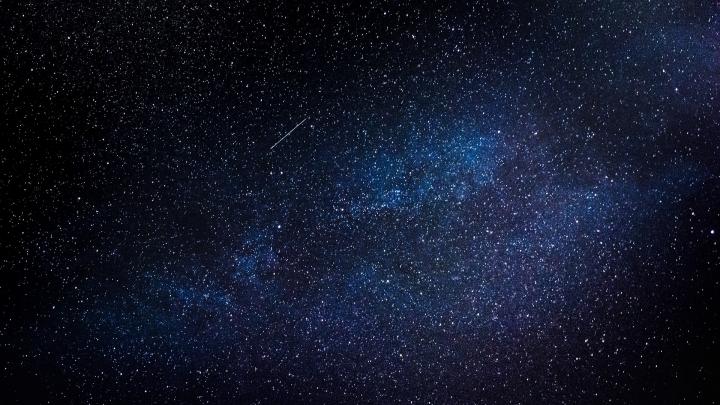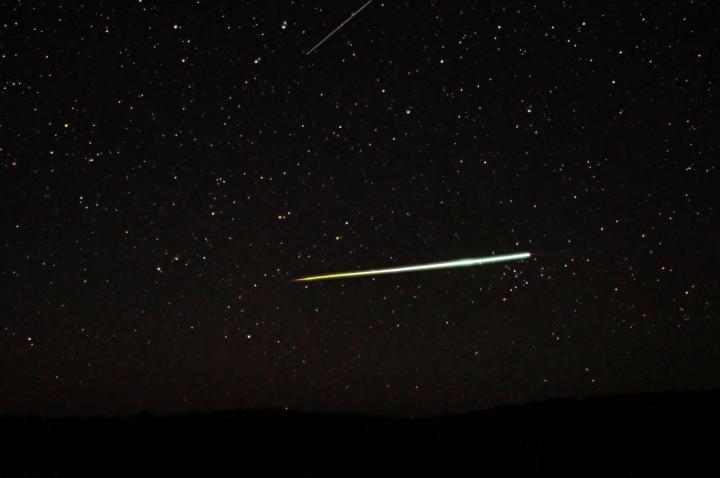One of the most frequent topics letter-writers contact us about is meteors. Also known as shooting stars or falling stars, they usually appear as fast streaks across the sky. People gasp when they see them. Although most are rather dim, they are occasionally brilliant and sometimes regarded as UFOs. Many wrong ideas abound. So here’s the true story.
What is a Meteor?
The average meteor is the size of an apple seed. It is a tiny fragment of a distant comet or asteroid and screams into our atmosphere at 20, 30, or even 40 miles per second. This high speed creates lots of air friction, which is what produces the brilliant streak. In most cases, you’re not observing the actual tiny meteoroid, but the superheated bubble of air surrounding it.
Friction with our atmosphere slows the meteor down. While first visible at a height of 80 or 100 miles above the ground, it stops glowing altogether when it’s about 30 miles up. By then, most meteors have disintegrated into dust, but occasionally, one will survive and keep falling invisibly until it hits the ground or some rooftop. In such cases, the final impact speed is only 250 or 300 miles an hour. That’s enough for the meteor to penetrate the roof and end up on someone’s bedroom floor. In 1982, one even continued through the first floor ceiling of a home in Wethersfield, Connecticut. In that case, the meteor is no longer hot and can be picked up immediately.
Actually, no one picks up a meteor. The name of the rock changes upon impact, so that thing you’re holding in your hand is now known as a meteorite.

How Rare are Meteors?
On any given night, an observer away from city light pollution will see around six meteors every hour, especially after 2:00 AM. There are more in the predawn hours because that’s when your part of Earth is facing forward in space, as Earth orbits the Sun at 18.5 miles per second. That’s when the sky overhead is slamming into meteors. Prior to midnight, meteors have to catch up to us from behind, so they’re slower and there are fewer of them.
Meteor intensity greatly increases a few nights a year when our planet slams into fragments from comets. But these meteor showers vary enormously in intensity. A minor shower, such as those in April and July, only increase the background rate by a few meteors per hour. Hardly worth the trouble. In contrast, the year’s two biggest major showers each average one shooting star a minute. These are the Perseids—on the nights of August 11 or 12—and the Geminids, on the night of December 13. A key predictor of meteor intensity is whether that night will have a fat, nearly-full Moon, which makes the sky so bright that only a few shooting stars are seen through the milky glow.
Another cool fact: We don’t get meteorites from meteor showers. That’s because meteor shower “shooting stars”—being comet fragments—are composed of ices. They’re too fragile to survive a sizzling trip through the atmosphere. So every meteorite you’ve seen at a museum or in a collection is really an asteroid fragment. Or, more rarely, a blasted-away piece of the Moon or Mars. But not comet material.
Keep Yours Eyes on the Sky
Every few decades, the Leonid meteors go from a minor shower to the year’s best spectacle. In the predawn hours of November 18, 2001, the Leonids averaged five brilliant shooting stars every minute. They were bright, they were green, and they left behind glowing trains that lingered for a few extra seconds like a Cheshire cat smile. For most of us, that was the best meteor shower of our lives. Unfortunately, the Leonids are not expected to produce a comparable spectacle again until November 18, 2099.
Sometimes, an orbiting satellite decays and comes crashing into the atmosphere and looks like a brilliant meteor. But even natural meteors can be spectacular. A meteor bright enough to cast shadows is called a fireball. One that explodes like a firework is called a bolide. Watch the sky long enough and you’ll see such awesome meteors sooner or later.

A bolide that appeared over Australia in 2011. Photo by C. M. Handler/Wikimedia Commons.
Meteorite… or Wrong?
Mistaken reports are a whole other topic. One letter-writer thought he often heard meteors hitting rooftops. A more common report is of a meteor that “came down in a neighbor’s yard.” It’s understandable, because a bright meteor can indeed seem as if it’s nearby. But remember, every visible meteor is roughly 60 to 80 miles from your eyes, and since they’ve slowed and stopped glowing by the time they hit the thick cold air 35 miles high, you’ll never see a meteor as close to you as even the most distant passenger jetliner.
As for finding meteorites, good luck. Using New York as a typical example, only 12 meteorites have been discovered in the entire history of that state. Odd-looking rocks are almost never meteorites. Many museums have collections of stones that people have brought in for analysis: they’re often referred to as “meteor wrongs.”
On the other hand, some serious collectors have traveled to places in the world where giant incoming meteors have broken into hundreds or thousands of fragments. Currently on e-bay, one can buy so-called “Campo” meteorites that landed centuries ago on a large field in Argentina. These are legitimate sellers, and the beautiful meteorite specimens are not particularly expensive. If you can afford a few hundred dollars, it’s certainly a conversation piece to display a large, heavy celestial stone—an actual asteroid fragment—in your living room.
This topic of meteors and meteorites never loses its fascination. It is the area of astronomy that most directly connects ourselves, and our planet, with the universe beyond.
Want to know when the next big meteor shower is going to be overhead? See our Meteor Shower Calendar to know the best dates!











